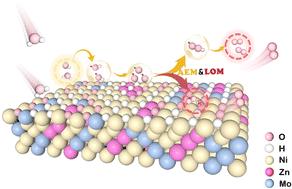具有协同AEM-LOM机制的远距离无序zno电催化剂高效析氧
IF 6.4
1区 化学
Q1 CHEMISTRY, INORGANIC & NUCLEAR
引用次数: 0
摘要
析氧反应(OER)的电催化剂由于其在水裂解制氢中的关键作用而引起了广泛的关注。本研究采用腐蚀工程的方法在泡沫镍上合成了一种远距离无序钼基催化剂(MoZn/NF)。合成的催化剂具有超亲水性表面,远程无序纳米片阵列和多孔通道,在OER过程中能够有效地暴露活性位点和有利的气泡扩散。此外,Zn的加入优化了*OH的表面吸附状态和反应动力学,将Mo/NF的吸附质演化机制(AEM)转变为MoZn/NF催化剂的吸附质演化与晶格氧参与的协同机制(AEM- lom),从而提高了催化剂的OER活性和稳定性。值得注意的是,在电流密度为10 mA cm−2时,它达到了241 mV的过电位,并在1 M KOH中保持了50小时的稳定性而没有明显的退化。此外,凭借其出色的整体水分解性能(1.58 V@10 mA cm−2),MoZn/NF电极可以由可持续能源提供动力,展示了其在可再生能源转换系统中的实际应用潜力。因此,本工作为激活双协同机制同时增强OER过程的活性和稳定性提供了可行的途径,为高效水电解制氢提供了有利条件。本文章由计算机程序翻译,如有差异,请以英文原文为准。

Long-range disordered MoZn electrocatalyst with a synergistic AEM-LOM mechanism for efficient oxygen evolution
Electrocatalysts for the oxygen evolution reaction (OER) have garnered substantial attention owing to their pivotal role in water splitting for hydrogen generation. In this study, corrosion engineering is employed to synthesize a long-range disordered MoZn-based catalyst on nickel foam (MoZn/NF). The synthesized catalyst features a superhydrophilic surface, long-range disordered nanosheet array, and porous channels, enabling effective active site exposure and favorable bubble diffusion during the OER. In addition, the incorporation of Zn optimizes the surface adsorption state of *OH and reaction kinetics, shifting the adsorbate evolution mechanism (AEM) of Mo/NF to the synergistic mechanism of adsorbate evolution and lattice oxygen participation (AEM-LOM) of the MoZn/NF catalyst, thereby enhancing the catalyst's OER activity and stability. Remarkably, at a current density of 10 mA cm−2, it achieves an overpotential of 241 mV and maintains stability for 50 hours without significant degradation in 1 M KOH. Moreover, with its outstanding performance in overall water splitting (1.58 V@10 mA cm−2), the MoZn/NF electrode can be powered by sustainable energy sources, showcasing its potential for practical applications in renewable energy conversion systems. Therefore, this work provides a feasible approach for simultaneously enhancing the activity and stability of the OER process by activating the dual synergistic mechanisms, and this approach provides favorable conditions for efficient water electrolysis to generate hydrogen.
求助全文
通过发布文献求助,成功后即可免费获取论文全文。
去求助
来源期刊

Inorganic Chemistry Frontiers
CHEMISTRY, INORGANIC & NUCLEAR-
CiteScore
10.40
自引率
7.10%
发文量
587
审稿时长
1.2 months
期刊介绍:
The international, high quality journal for interdisciplinary research between inorganic chemistry and related subjects
 求助内容:
求助内容: 应助结果提醒方式:
应助结果提醒方式:


